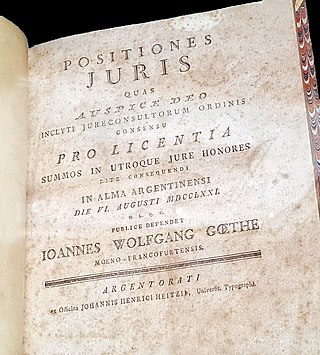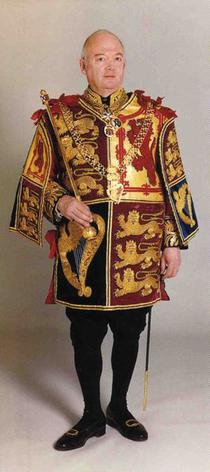
Heraldry is a discipline relating to the design, display and study of armorial bearings, as well as related disciplines, such as vexillology, together with the study of ceremony, rank and pedigree. Armory, the best-known branch of heraldry, concerns the design and transmission of the heraldic achievement. The achievement, or armorial bearings usually includes a coat of arms on a shield, helmet and crest, together with any accompanying devices, such as supporters, badges, heraldic banners and mottoes.

A coat of arms is a heraldic visual design on an escutcheon, surcoat, or tabard. The coat of arms on an escutcheon forms the central element of the full heraldic achievement, which in its whole consists of a shield, supporters, a crest, and a motto. A coat of arms is traditionally unique to the armiger. The term 'coat of arms' itself, describing in modern times just the heraldic design, originates from the description of the entire medieval chainmail 'surcoat' garment used in combat or preparation for the latter.
L'Académie Internationale d'Héraldique was founded in Paris in 1949 to bring together experts in heraldry representing the various areas of the world. Admission is by election, and the number of active academicians is limited to 75. There is no limit to the number of associate members.

A licentiate is an academic degree present in many countries, representing different educational levels. It may be similar to a master's degree when issued by pontifical universities and other universities in Europe, Latin America, and Syria.

The Heraldry Society is a British organization that is devoted to studying and promoting heraldry and related subjects. In 1947, a twenty-year-old John Brooke-Little founded the Society of Heraldic Antiquaries. This name was changed to The Heraldry Society in 1950. It was incorporated in 1956 and is now a registered educational charity, with the registered charity number 241456.

Heraldry in Scotland, while broadly similar to that practised in England and elsewhere in western Europe, has its own distinctive features. Its heraldic executive is separate from that of the rest of the United Kingdom.

John Philip Brooke Brooke-Little was an English writer on heraldic subjects, and a long-serving herald at the College of Arms in London. In 1947, while still a student, Brooke-Little founded the Society of Heraldic Antiquaries, now known as the Heraldry Society and recognised as one of the leading learned societies in its field. He served as the society's chairman for 50 years and then as its president from 1997 until his death in 2006.

The Cambridge University Heraldic and Genealogical Society was formed as the result of the merger in 1957 of a previous Heraldic Society with the Cambridge University Society of Genealogists.
Charles WilfridScott-Giles was an English writer on heraldry and an officer of arms, who served as Fitzalan Pursuivant Extraordinary.

D'Arcy Jonathan Dacre Boulton is a Canadian medieval historian, and heraldic author and artist.

David Hubert Boothby Chesshyre was a British officer of arms.

Arthur Charles Fox-Davies was a British expert on heraldry. His Complete Guide to Heraldry, published in 1909, has become a standard work on heraldry in England. A barrister by profession, Fox-Davies worked on several notable cases involving the peerage, and also worked as a journalist and novelist.
Cecil Raymond Julian Humphery-Smith was a British genealogist and heraldist.

Frederick Gordon Brownell was a South African herald, vexillologist, and genealogist.

English heraldry is the form of coats of arms and other heraldic bearings and insignia used in England. It lies within the so-called Gallo-British tradition. Coats of arms in England are regulated and granted to individuals by the English kings of arms of the College of Arms. An individual's arms may also be borne 'by courtesy' by members of the holder's nuclear family, subject to a system of cadency marks, to differentiate those displays from the arms of the original holder. The English heraldic style is exemplified in the arms of British royalty, and is reflected in the civic arms of cities and towns, as well as the noble arms of individuals in England. Royal orders in England, such as the Order of the Garter, also maintain notable heraldic bearings.
The RMIT School of Accounting is an Australian university business school located in Melbourne, Victoria, which is responsible for undergraduate and postgraduate education and research in accounting at RMIT University. The School was established in 1943 and its name was changed to the School of Accountancy in 1948.
Anthony Wood, FSHA, FSSI was a British heraldic artist and a master of heraldry.
For the purposes of this article, heraldry societies are defined as private associations of people who are interested in heraldry. Heraldic authorities, which have been established by reigning monarchs or governments, are dealt with in a separate article.

The International Commission for Orders of Chivalry is a privately run, privately funded organisation composed of scholars on chivalric matters and systems of awards. Founded in 1960, its stated purpose is to examine orders of chivalry to determine their legitimacy. Its president since 1999 is Pier Felice degli Uberti, and its seat is situated in Milan, Italy.

The armorial of British universities is the collection of coats of arms of universities in the United Kingdom. Modern arms of universities began appearing in England around the middle of the 15th century, with Oxford's being possibly the oldest university arms in the world, being adopted around the end of the 14th century. The earliest granting of university arms was to King's College Cambridge by Henry VI in 1449. Arms are granted by the College of Arms and Lyon Court. It has been suggested that new universities register arms in an attempt to appear more traditional or legitimate. As corporations, older university arms have historically been granted without a crest, however newer institutions use crests with mantling, including new colleges at older universities. The first crest granted to a university was to Leeds in 1905 while the first British university to be granted supporters was Sussex in 1962, although both Oxford and Cambridge have used angels as supporters and Cambridge has used the 'alma mater' emblem as a crest without these components being officially granted.














